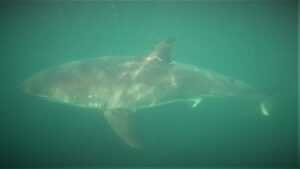Canadian tracking network part of worldwide effort to study shark populations
Heather Bowlby’s job is pretty exciting. She’s the Research Lead at the Canadian Atlantic Shark Research Laboratory at the federal Bedford Institute of Oceanography in Dartmouth, Nova Scotia.
But what she’s most excited about is the made-in-Canada initiative called the Ocean Tracking Network (OTN). It combines acoustic tagging and receiver technology with a global network of people monitoring the movements, habitats and survival of ocean animals. Its mission is to inform the sustainable management and stewardship of aquatic animals in the face of changing global environments.
OTN launched in 2008 with support from the Canada Foundation for Innovation, with research funding from the Natural Sciences and Engineering Research Council of Canada. Industry partners such as the Halifax-based VEMCO (acquired by Innovasea in 2019) researched, developed and now provide OTN with the Canadian-built acoustic technology.
Today, OTN also benefits from support and engagement from Fisheries and Oceans Canada, as well as other research and government agencies, international academia and Indigenous communities. It serves more than 400 researchers in 30 countries, and is tracking more than 160 aquatic species, including whales, cod, sea turtles and sharks.
“Sea animals such as sharks are extremely hard to monitor,” Bowlby said in an interview. “For a land mammal like a bear, you can put a collar on it and know what it’s doing for its entire life. But for fish in the ocean, it’s a different story.
“Instead, we tag a shark with this acoustic technology, which gives off a bar-coded signal, kind of like a morse code, with each shark having its own signature code. As the shark swims past a receiver, it picks up the sound and records which individual it is.”
While most people are familiar with the great white shark, famously portrayed in the movies Jaws, there is actually a lot of diversity in the shark community. And of the hundreds of species of sharks found around the world, 28 have been sighted in Canada, 14 of which are commonly found.
For example, Canada’s northern Pacific Coast is home to the salmon shark, a predator that feeds on salmon, squid and herring, and whose population is stable and abundant. In Atlantic Canada, there are small species such as the black dogfish, which are not much larger than haddock or cod. Then there are members of the large pelagic (open sea) species, such as basking sharks and white sharks, both of which are species-at-risk. Atlantic Canada also receives occasional seasonal visitors, such as the tiger shark and dusky shark.
According to Bowlby, the endangered white shark is one of the easier species to monitor because they swim closer to shore than many other shark species found in Canada. OTN acoustic technology is generally set up near the shore, where it’s possible to moor a buoy with the receiver.
When Bowlby’s team has tried to tag and track shark species that don’t tend to frequent coastal environments, such as the blue or porbeagle shark, the information they received from the acoustic receivers was very, very sparse.
Collaboration is key to the tracking network
For their white shark monitoring, Bowlby and her team used information from more than 6,900 acoustic receivers in Canadian waters, representing deployments archived by OTN during 2010 to 2020. “Sharks are so wide-ranging and the ocean is a really big place,” said Bowlby. “You can find the same shark detected in Newfoundland down in Bermuda’s Sargasso Sea later that year. So you need a very widely dispersed effort and the OTN is a great way to get that.”
“A lot of people focus on the tagging component of OTN,” added Bowlby. “But it’s really the collective monitoring from so many different people and places that gives us the information we need. That may not be the sexy part, but it’s the important part.”
The white shark is an endangered species. Photo courtesy the Canadian Atlantic Shark Research Laboratory.
A recently released study by Bowlby and her team used the OTN acoustic technology and network to determine population patterns of the white shark in Canadian waters. With information from 227 tagged sharks, they found that only about a quarter of them made the annual trip to Atlantic Canadian waters, mostly in June through November. These tend to be younger sharks who are probably here to feed and tend to remain coastal. Bowlby’s team also found that detections have remained relatively stable in recent years.
The hope is that this valuable information can function as a baseline so that they can create a plan for the endangered white shark’s recovery, as well as see how climate change might be affecting its population and movement.
The challenge with sharks is that there is very little historical information about their distributions before climate change. However, Bowlby believes that the OTN can help them get at these kinds of questions moving forward.
“OTN is truly a collaborative science effort. Bringing together the efforts of many scientists from around the world is the way to answer complicated questions such as the impact of climate change on shark populations. As more and more researchers tie into the network, the potential for scientific data collection and knowledge just keeps growing.”
R$
| Organizations: | |
| People: | |
| Topics: |
Events For Leaders in
Science, Tech, Innovation, and Policy
Discuss and learn from those in the know at our virtual and in-person events.
See Upcoming Events
You have 1 free article remaining.
Don't miss out - start your free trial today.
Start your FREE trial Already a member? Log in
By using this website, you agree to our use of cookies. We use cookies to provide you with a great experience and to help our website run effectively in accordance with our Privacy Policy and Terms of Service.






